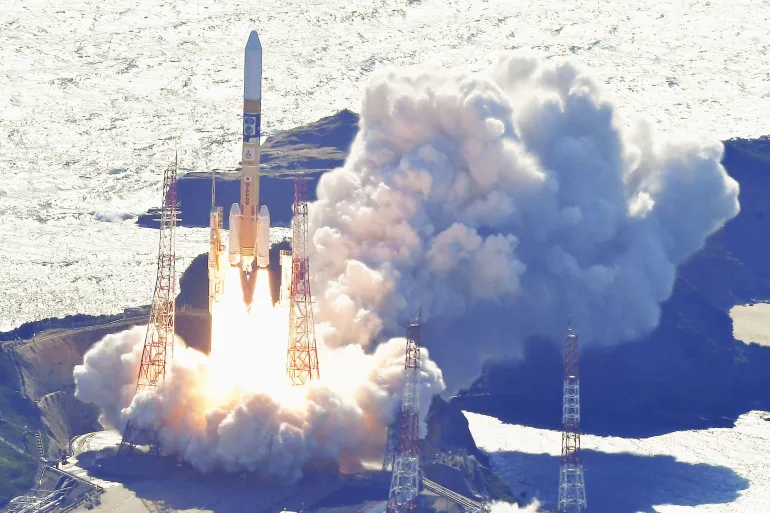The Japanese H2-A rocket carried the Moon Sniper lander, which is scheduled to settle on the moon in four to six months.
Japan become fourth country launches moon mission
Japan launched a rocket carrying what it hopes would be the country’s first successful Moon landing on Thursday (September 7), as shown in live footage broadcast by the country’s space agency.
The H2-A rocket, carrying the precision “Moon Sniper” lander, took launch at 8:42 a.m. (2342 GMT Wednesday) and is anticipated to arrive on the lunar surface in four to six months.
After being delayed three times owing to inclement weather, the rocket was launched from Tanegashima in southern Japan and attracted some 35,000 internet watchers.
Additionally, a research satellite created by NASA, the European Space Agency, and the Japan Aerospace Exploration Agency (JAXA) is being carried by the rocket.

Just one month had passed since India’s probe made a historic landing close to the Moon’s south pole, when Japan launched its own moon lander.
The Smart Lander for Investigating Moon (SLIM), a small Japanese lander, has been created to successfully land within 100 metres of a chosen target on the Moon’s surface.
According to JAXA, before the launch, “by developing the SLIM lander, humans will undergo a qualitative shift towards being able to land where we want and not just where it is easy to land.”
By accomplishing this, it will be feasible to set foot on worlds that have even fewer resources than the Moon. There have never been any precise landings on celestial bodies with strong gravity, like the Moon, according to the world.India became the first nation to do so on the south pole. Up until this point, only the United States, Russia, China, and India have been able to land their spacecraft on the Moon’s surface. All of Japan’s prior attempts have been unsuccessful, including the Omotenashi lunar probe that was launched last year as part of the American Artemis programme.
The world’s tiniest Moon landing would have been Omotenashi, which was the size of a knapsack. The mission encountered problems after the probe was launched by NASA’s strong rocket from the Kennedy Space Centre in Florida, and eventually they lost contact with it.
After the next-generation H3 model failed shortly after takeoff in March and the dependable solid-fuel Epsilon failed in October, Japan likewise experienced issues with launch rockets.
Exploring the Skies: A Comprehensive Look at JAXA
In the realm of space exploration and scientific research, few organizations hold the prestige and expertise that the Japan Aerospace Exploration Agency, or JAXA, boasts. Established in 2003, JAXA has quickly become a global leader in space technology, contributing significantly to our understanding of the universe and our place within it. This article will delve into the fascinating world of JAXA, its remarkable achievements, and its pivotal role in advancing space science.
Origins and Mission
JAXA’s inception can be traced back to the merger of three prominent Japanese space agencies: the National Space Development Agency of Japan (NASDA), the Institute of Space and Astronautical Science (ISAS), and the National Space Development Agency (NADA). This union was aimed at consolidating Japan’s resources and expertise in space research and development.
The agency’s mission is multi-faceted and encompasses a wide range of objectives, including:
- Space Exploration: JAXA has been instrumental in various space missions, such as the Hayabusa series, which successfully returned samples from asteroids Itokawa and Ryugu. These missions have provided valuable insights into the formation of our solar system.
- Satellite Deployment: JAXA operates numerous Earth-observing satellites that monitor our planet’s climate, weather, and environmental changes. These satellites play a crucial role in disaster management and resource management.
- International Collaborations: JAXA collaborates extensively with other space agencies, including NASA and ESA, on projects like the International Space Station (ISS) and the Artemis program, which aims to return humans to the Moon.
JAXA’s contributions to space science have been nothing short of remarkable. Some of its notable achievements include:
Notable Achievements
- Hayabusa Missions: The Hayabusa spacecraft series successfully collected and returned samples from two asteroids, enhancing our understanding of the early solar system’s composition and history.
- Kibo Laboratory: JAXA’s Kibo laboratory module, part of the ISS, has provided a unique platform for international researchers to conduct experiments in microgravity. It has played a pivotal role in scientific advancements.
- Lunar Exploration: JAXA’s lunar orbiter, SELENE (Kaguya), provided invaluable data about the Moon’s geology and surface features. The agency is also planning a lunar rover mission in collaboration with NASA.
- Space Telescopes: JAXA launched the X-ray astronomy satellite Suzaku and the infrared astronomy satellite AKARI, both of which have made significant contributions to our understanding of the cosmos.
Future Endeavors
JAXA’s ambitions for the future are equally exciting. The agency continues to explore the Moon with the SELENE-2 mission and is actively involved in NASA’s Artemis program. Additionally, JAXA is developing the Martian Moons Exploration (MMX) mission, which aims to study the Martian moons Phobos and Deimos. These endeavors are crucial steps toward advancing our knowledge of the solar system and beyond.
Conclusion
The Japan Aerospace Exploration Agency, JAXA, stands as a testament to human ingenuity and the pursuit of knowledge. Its remarkable achievements in space exploration and scientific research have not only enriched our understanding of the universe but also reinforced Japan’s position as a leader in the global space community. As JAXA continues to reach for the stars, its contributions to space science are destined to leave an indelible mark on humanity’s journey into the cosmos.




































